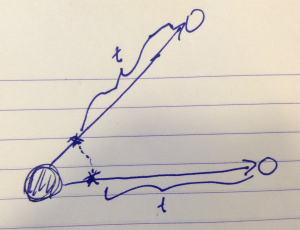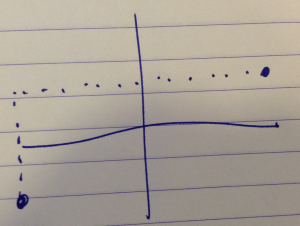[Click here for a PDF of this post with nicer formatting]
Q: Show that
This is ([1] pr. 3.3)
Given the matrix
\begin{equation}\label{eqn:unimodularAndRotation:20}
U =
\frac
{a_0 + i \sigma \cdot \Ba}
{a_0 – i \sigma \cdot \Ba},
\end{equation}
where \( a_0, \Ba \) are real valued constant and vector respectively.
- Show that this is a unimodular and unitary transformation.
- A unitary transformation can represent an arbitary rotation. Determine the rotation angle and direction in terms of \( a_0, \Ba \).
A: unimodular
Let’s call these factors \( A_{\pm} \), which expand to
\begin{equation}\label{eqn:unimodularAndRotation:40}
\begin{aligned}
A_{\pm}
&=
a_0 \pm i \sigma \cdot \Ba \\
&=
\begin{bmatrix}
a_0 \pm i a_z & \pm \lr{ a_y + i a_x} \\
\mp (a_y – i a_x) & a_0 \mp i a_z \\
\end{bmatrix},
\end{aligned}
\end{equation}
or with \( z = a_0 + i a_z \), and \( w = a_y + i a_x \), these are
\begin{equation}\label{eqn:unimodularAndRotation:120}
A_{+}
=
\begin{bmatrix}
z & w \\
-w^\conj & z^\conj
\end{bmatrix}
\end{equation}
\begin{equation}\label{eqn:unimodularAndRotation:180}
A_{-}
=
\begin{bmatrix}
z^\conj & -w \\
w^\conj & z
\end{bmatrix}.
\end{equation}
These both have a determinant of
\begin{equation}\label{eqn:unimodularAndRotation:60}
\begin{aligned}
\Abs{z}^2 + \Abs{w}^2
&=
\Abs{a_0 + i a_z}^2 + \Abs{a_y + i a_x}^2 \\
&= a_0^2 + \Ba^2.
\end{aligned}
\end{equation}
The inverse of the latter is
\begin{equation}\label{eqn:unimodularAndRotation:200}
A_{-}^{-1}
=
\inv{ a_0^2 + \Ba^2 }
\begin{bmatrix}
z & w \\
-w^\conj & z^\conj
\end{bmatrix}
\end{equation}
Noting that the numerator and denominator commute the inverse can be applied in either order. Picking one, the transformation of interest, after writing \( A = a_0^2 + \Ba^2 \), is
\begin{equation}\label{eqn:unimodularAndRotation:100}
\begin{aligned}
U
&=
\inv{A}
\begin{bmatrix}
z & w \\
-w^\conj & z^\conj
\end{bmatrix}
\begin{bmatrix}
z & w \\
-w^\conj & z^\conj
\end{bmatrix} \\
&=
\inv{A}
\begin{bmatrix}
z^2 – \Abs{w}^2 & w( z + z^\conj) \\
-w^\conj (z^\conj + z ) & (z^\conj)^2 – \Abs{w}^2
\end{bmatrix}.
\end{aligned}
\end{equation}
Recall that a unimodular transformation is one that has the form
\begin{equation}\label{eqn:unimodularAndRotation:140}
\begin{bmatrix}
z & w \\
-w^\conj & z^\conj
\end{bmatrix},
\end{equation}
provided \( \Abs{z}^2 + \Abs{w}^2 = 1 \), so \ref{eqn:unimodularAndRotation:100} is unimodular if the following sum is unity, which is the case
\begin{equation}\label{eqn:unimodularAndRotation:160}
\begin{aligned}
\frac{\Abs{z^2 – \Abs{w}^2}^2}{\lr{ \Abs{z}^2 + \Abs{w}^2}^2 } + \Abs{w}^2 \frac{\Abs{z + z^\conj}^2 }{\lr{ \Abs{z}^2 + \Abs{w}^2}^2 }
&=
\frac{
\lr{ z^2 – \Abs{w}^2 } \lr{ (z^\conj)^2 – \Abs{w}^2 }
+ \Abs{w}^2 \lr{ z + z^\conj }^2
}{
\lr{ \Abs{z}^2 + \Abs{w}^2}^2
} \\
&=
\frac{
\Abs{z}^4 + \Abs{w}^4 – \Abs{w}^2 \lr{ {z^2 + (z^\conj)^2} }
+ \Abs{w}^2 \lr{ {z^2 + (z^\conj)^2} + 2 \Abs{z}^2 }
}{
\lr{ \Abs{z}^2 + \Abs{w}^2}^2
} \\
&= 1.
\end{aligned}
\end{equation}
A: rotation
The most general rotation of a vector \( \Ba \), described by Pauli matrices is
\begin{equation}\label{eqn:unimodularAndRotation:220}
e^{i \Bsigma \cdot \ncap \theta/2}
\Bsigma \cdot \Ba
e^{-i \Bsigma \cdot \ncap \theta/2}
=
\Bsigma \cdot \ncap + \lr{ \Bsigma \cdot \Ba – (\Ba \cdot \ncap) \Bsigma \cdot \ncap } \cos \theta + \Bsigma \cdot (\Ba \cross \ncap) \sin\theta.
\end{equation}
If the unimodular matrix above, applied as \( \Bsigma \cdot \Ba’ = U^\dagger \Bsigma \cdot \Ba U \) is to also describe this rotation, we want the equivalence
\begin{equation}\label{eqn:unimodularAndRotation:240}
U = e^{-i \Bsigma \cdot \ncap \theta/2},
\end{equation}
or
\begin{equation}\label{eqn:unimodularAndRotation:260}
\inv{a_0^2 + \Ba^2}
\begin{bmatrix}
a_0^2 – \Ba^2 + 2 i a_0 a_z & 2 a_0 ( a_y + i a_x ) \\
-2 a_0( a_y – i a_x ) & a_0^2 – \Ba^2 – 2 i a_0 a_z
\end{bmatrix}
=
\begin{bmatrix}
\cos(\theta/2) – i n_z \sin(\theta/2) & (-n_y -i n_x) \sin(\theta/2) \\
-( – n_y + i n_x ) \sin(\theta/2) & \cos(\theta/2) + i n_z \sin(\theta/2)
\end{bmatrix}.
\end{equation}
Equating components, that is
\begin{equation}\label{eqn:unimodularAndRotation:280}
\begin{aligned}
\cos(\theta/2) &= \frac{a_0^2 – \Ba^2}{a_0^2 + \Ba^2} \\
-n_x \sin(\theta/2) &= \frac{2 a_0 a_x}{a_0^2 + \Ba^2} \\
-n_y \sin(\theta/2) &= \frac{2 a_0 a_y}{a_0^2 + \Ba^2} \\
-n_z \sin(\theta/2) &= \frac{2 a_0 a_y}{a_0^2 + \Ba^2} \\
\end{aligned}
\end{equation}
Noting that
\begin{equation}\label{eqn:unimodularAndRotation:300}
\begin{aligned}
\sin(\theta/2)
&=
\sqrt{
1 – \frac{(a_0^2 – \Ba^2)^2}{(a_0^2 + \Ba^2)^2}
} \\
&=
\frac{
\sqrt{ (a_0^2 + \Ba^2)^2 – (a_0^2 – \Ba^2)^2 }
}
{
a_0^2 + \Ba^2
} \\
&=
\frac{\sqrt{ 4 a_0^2 \Ba^2 }}{a_0^2 + \Ba^2} \\
&=
\frac{2 a_0 \Abs{\Ba} }{a_0^2 + \Ba^2}
\end{aligned}
\end{equation}
The vector normal direction can be written
\begin{equation}\label{eqn:unimodularAndRotation:320}
\Bn
= – \frac{2 a_0}{(a_0^2 + \Ba^2) \sin(\theta/2)} \Ba,
\end{equation}
or
\begin{equation}\label{eqn:unimodularAndRotation:340}
\boxed{
\Bn = – \frac{\Ba}{\Abs{\Ba}}.
}
\end{equation}
The angle of rotation is
\begin{equation}\label{eqn:unimodularAndRotation:380}
\boxed{
\theta = 2 \tan^{-1} \frac{2 a_0 \Abs{\Ba}}{ a_0^2 – \Ba^2}.
}
\end{equation}
References
[1] Jun John Sakurai and Jim J Napolitano. Modern quantum mechanics. Pearson Higher Ed, 2014.

